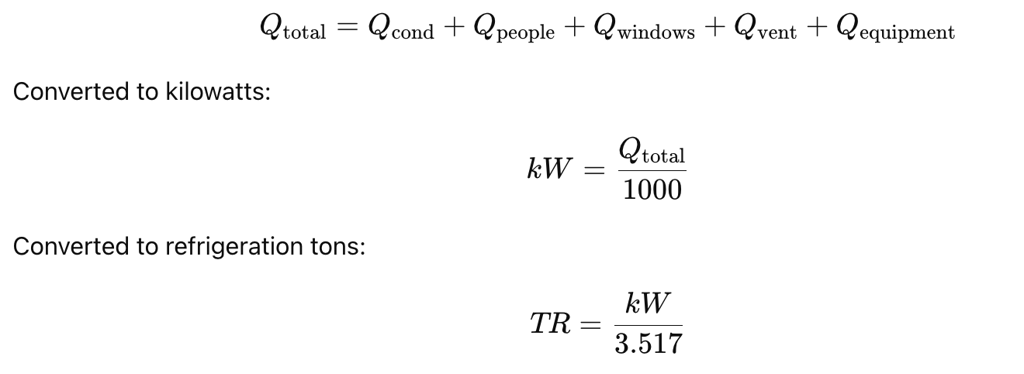Cooling Load Calculator
Cooling Load Calculator
Wiratama
11/16/20252 min read
1. Definition
A Cooling Load Calculator estimates the amount of heat (in kW or TR) that must be removed from a space to maintain a desired indoor temperature. Cooling load accounts for heat gain from walls, windows, people, appliances, and ventilation.
This tool is widely used in HVAC design for sizing air conditioners, chillers, and ventilation systems.
2. Background Theory
Cooling load is the total heat entering a room due to:
1. Heat Conduction (Walls, Floor, Ceiling)
Heat transfer occurs whenever outdoor temperature is higher than indoor temperature.
A simplified form is:

Where:
AAA = area (m²)
UUU = overall heat transfer coefficient (W/m²·°C)
ΔT\Delta TΔT = temperature difference
For simplified calculators, an average “heat gain factor” is applied.
2. Heat Gain from People
Each person adds sensible + latent heat:


(120 W is typical for offices/houses)
3. Solar Heat Gain from Windows
Depends on area, glazing type, and ΔT:

4. Internal Loads (Equipment, Appliances)
Every electrical device ultimately releases heat:

5. Ventilation / Fresh Air Load
Heat from outside air introduced for ventilation:


Total Cooling Load
The calculator sums all contributions:


4. How the Calculator Works
The calculator performs the following steps:
User inputs:
Room area
People count
Appliances wattage
Window area
Temperature difference
Ventilation rate
The script computes:
Conduction load (walls, floor, ceiling)
People heat load
Window heat gain
Ventilation heat load
Appliances load
Sums all loads into Watts
Converts to kW
Converts to Tons of Refrigeration (TR)
Finally, it displays:
Total cooling load
Load breakdown for each component
Here is a single, smooth bridging paragraph connecting your HVAC calculators to the promotion of tensorHVAC-Pro:
As you explore these HVAC calculators to size cooling loads, ducts, pumps, and airflow requirements, you may find that real-world HVAC systems often involve complex air movement, room pressurization, thermal comfort patterns, and equipment interactions that go far beyond what manual formulas can capture. This is where tensorHVAC-Pro comes in—a dedicated HVAC flow and thermal simulation software built specifically for HVAC engineers, not CFD experts. tensorHVAC-Pro lets you visualize airflow, temperature distribution, ventilation performance, and system efficiency through an intuitive interface, enabling accurate design decisions without needing deep CFD knowledge.


